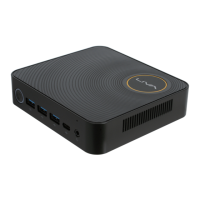
Do you have a question about the ECS LIVA Z and is the answer not in the manual?
| Memory slots | 2x SO-DIMM |
|---|---|
| Internal memory | 4 GB |
| Internal memory type | DDR3L-SDRAM |
| Maximum internal memory | 8 GB |
| Storage media | eMMC |
| Optical drive type | No |
| Total storage capacity | 64 GB |
| Ethernet LAN | Yes |
| Bluetooth version | 4.0 |
| Cabling technology | 10/100/1000Base-T(X) |
| Top Wi-Fi standard | Wi-Fi 5 (802.11ac) |
| Ethernet LAN data rates | 10, 100, 1000 Mbit/s |
| Discrete graphics card model | Not available |
| On-board graphics card model | Intel® HD Graphics 500 |
| HDMI version | 1.4 |
| USB 2.0 ports quantity | 0 |
| Ethernet LAN (RJ-45) ports | 2 |
| USB 3.2 Gen 1 (3.1 Gen 1) Type-A ports quantity | 3 |
| Chassis type | - |
| Product color | Black |
| Placement supported | Horizontal |
| Operating system architecture | 64-bit |
| Product type | Mini PC |
| Processor cache | 2 MB |
| Processor model | N3350 |
| Processor family | Intel® Celeron® N |
| Processor frequency | 1.1 GHz |
| Power supply input voltage | 100 - 240 V |
| Intel Identity Protection Technology version | 1.00 |
| Intel Small Business Advantage (SBA) version | 0.00 |
| Depth | 128 mm |
|---|---|
| Width | 117 mm |
| Height | 33 mm |
| Weight | - g |
General introduction to the manual's content and scope.
Legal notice regarding the protection of the publication's content under copyright laws.
Legal notice stating that information is subject to change and disclaiming warranties.
Lists recognized product trademarks and acknowledges their respective owners.
Instructions for proper system placement and ventilation for safe operation.
Warnings and precautions for safe handling and operation of the system.
Safety guidelines specific to the laser product within the optical drive.
Information on the proper disposal of electronic equipment according to local regulations.
Warnings and precautions for handling and replacing lithium-ion batteries.
Compliance statement for Canadian interference-causing equipment regulations.
Overview of the manual's structure and content organization.
A general welcome and overview of the product's design, performance, and capabilities.
Description of the motherboard's internal connectors and headers.
Details the required power adapter specifications for the system.
Provides the PC's physical size and VESA mounting information.
Details the USB ports and power button on the front of the PC.
Details audio jack, display ports, LAN ports, and DC power input on the rear.
A diagram showing the physical arrangement and labels of key motherboard components.
A list matching motherboard component labels to their descriptions.
Shows the pin configuration for the BT1 battery connector.
Shows the pin configuration for the SYS_FAN connector.
Shows the pin configuration for the DMIC1 connector.
Explains the purpose, function, and capabilities of the BIOS Setup Utility.
Describes default BIOS settings and when to use the setup utility.
Step-by-step guide on how to access the BIOS setup utility.
Details BIOS information like language, date, time, and version.
Summarizes the various advanced configuration categories available in the BIOS.
Explains settings related to onboard LAN controllers.
Details options for configuring system power management features.
Describes how to monitor system voltages, temperatures, and fan speeds.
Explains settings for the Embedded Multimedia Card storage.
Describes options for configuring SATA storage devices and modes.
Details settings for enabling or disabling Wi-Fi and Bluetooth.
Explains settings related to Advanced Configuration and Power Interface.
Covers settings related to the CPU's operation and features.
Provides detailed information about the installed CPU.
Details settings for managing CPU power consumption and performance.
Explains settings for enabling or disabling USB ports and legacy support.
Describes settings for the Super IO chip, including serial ports.
Details settings for the system's serial ports (COM1-COM4).
Explains configuration options for Trusted Computing features.
Accesses settings related to the system chipset and SoC.
Displays information and settings for the platform's firmware.
Provides configuration options for the System on Chip (SoC).
Shows version information for firmware components like MRC, P-Unit, PMC, TXE, and GOP.
Details settings for graphics memory allocation (DVMT) and audio.
Details settings for enabling and managing secure boot functionality.
Instructions on how to install the Windows operating system via DVD or USB.
Explains the automatic installation process for drivers and software from the DVD.
Guides the user through the steps of running the driver setup program.
Provides instructions for installing drivers manually if auto-installation fails.
Describes the ECS Intelligent EZ Utility for system management.
Explains utilities for updating drivers (eDLU) and BIOS (eBLU).
Introduces options for recovering the Windows 8.1 operating system.
Steps to refresh the PC, removing apps but keeping personal files.
Steps to reset the PC, which deletes personal files and reinstalls Windows.
Instructions on using System Restore to revert the PC to a previous state.
Information regarding repair services and customer data responsibility.
An overview of the chapter's purpose in addressing common PC issues.
Steps to diagnose and resolve issues preventing the system from starting.
Steps to diagnose and resolve issues with the display output.
Steps to resolve issues related to graphics driver errors.
Steps to diagnose and resolve issues with wired network connectivity.
Steps to diagnose and resolve issues with wireless network connectivity.
Steps to diagnose and resolve audio output problems.
